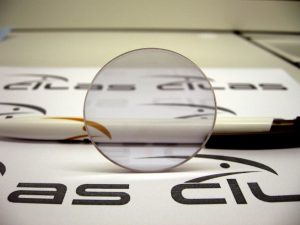A pinch of magnesium can affect the structure and the optical properties of transparent ceramics
|Not only glasses and crystals but also ceramics are being employed in many applications where toughness and transparency are a required feature. Prof. Iva Matolínová from the CERIC Czech partner facility at Charles University in Prague, Dr. Ihor Vorona from the Institute for Single Crystals- NAS of Ukraine, and colleagues, tested different amounts of magnesium oxide as a sintering aid for the production of YAG transparent ceramics.

The object in the picture above might appear as a conventional glass lens, but conversely, it’s a ceramic. While traditional ones, as we are used in everyday life, are opaque and fragile, modern production techniques allowed for the realisation of ceramics with stunning properties.
Advanced ceramics can be transparent and highly resistant; therefore, they have applications in defence, optics, electronics, laser technology, and communications. Some examples are helicopter windows, transparent armours, and active elements in high-power solid-state lasers. For the latter, it is common the use of Yttrium Aluminum Garnet, or YAG, doped with impurities like ytterbium or neodymium. YAG, as other transparent ceramics, can be produced in high volumes with low costs through a process called sintering, where fine powders are heated below the melting point to make a dense monolithic material.
The physical and structural properties of the material rely on the sintering process. To have a transparent ceramic, for instance, it’s crucial to avoid the presence of pores and segregated secondary phases in the structure, by employing additives that promote densification.

The team of scientists, which includes CERIC user Dr. Serhii Parkhomenko, from the Institute for Single Crystals- NAS of Ukraine, tested magnesium as a sintering aid by adding increasing amounts of magnesium oxide to the sintering of YAG. As can be seen in the picture above, tiny amounts of magnesium caused dramatic changes to the microscopic structure of YAG, and therefore, on the optical properties of the material. Best results were obtained by adding 0.03-0.06% of the total weight. Above this threshold, the optical properties start to degrade mostly because of inclusions of magnesium and aluminum, as highlighted by the Field Emission Scanning Electron Microscope, available at the CERIC Czech partner facility at Charles University Prague. Advancements like this will provide innovative solutions in electronics, optics, aviation and more.



